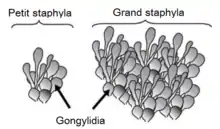
French depiction of gongylidia and staphylae in different sizes.
Gongylidia (singular gongylidium) are hyphal swellings of fungus cultivated by higher-attine genera of fungus-growing ants. This fungus no longer exists naturally outside the ant colonies.
Developing larvae feed on the gongylidia and distributed throughout the colony to feed workers, soldiers, and the queen.[1] They are ellipsoid, about 30-50 micrometres in diameter,[2] rich in lipids and carbohydrates derived from the leaves,[3] and are produced in clusters (called staphylae).[4]

Photograph of gongylidia (G) and staphylae (S) in a fungal garden taken care of by Acromyrmex echinatior.
See also
References
- ↑ Raupp, Michael J. (February 12, 2007). "Bug of the Week". Archived from the original on 2011-07-20. Retrieved 2019-12-31.
- ↑ Gover, D.W. "Fungal Agriculture and Engineering in Ants" (PDF).
- ↑ Currie, Cameron R. (October 2001). "A community of Ants, Fungi, and Bacteria: A Multilateral Approach to Studying Symbiosis" (PDF). Annual Review of Microbiology. 55 (1): 357–380. doi:10.1146/annurev.micro.55.1.357. hdl:1808/835. PMID 11544360. Retrieved 2021-01-14.
- ↑ "Integrative Biology" (PDF). Biosci.utexas.edu. Retrieved 2015-11-06.
This article is issued from Wikipedia. The text is licensed under Creative Commons - Attribution - Sharealike. Additional terms may apply for the media files.